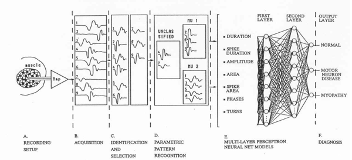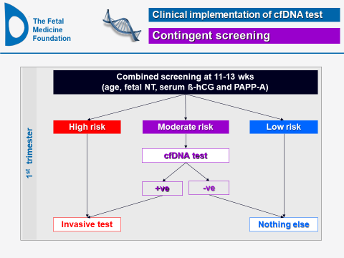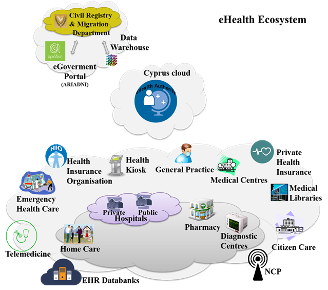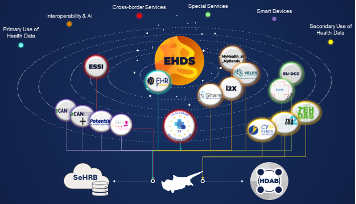 |
eHealth and COMPUTATIONAL INTELLIGENCE |
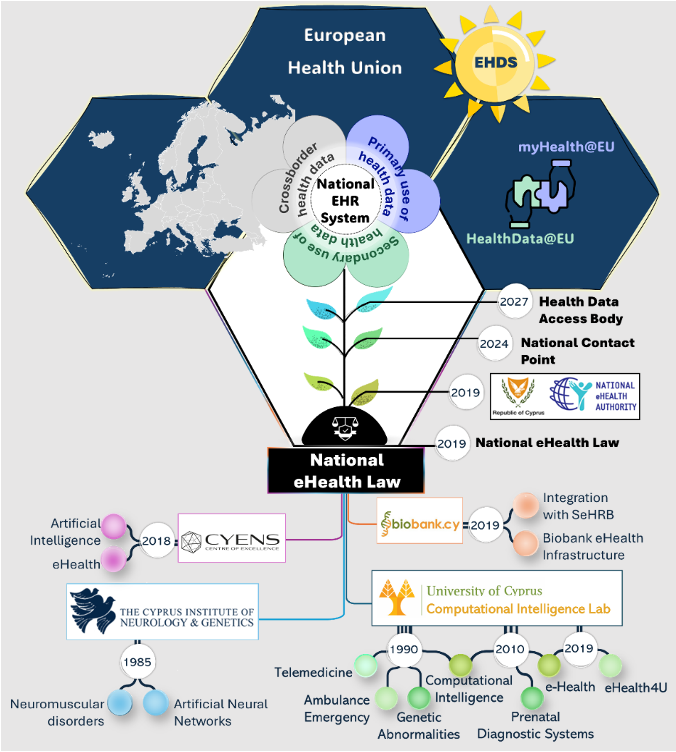

“Invest in health to avoid illness”
”Όταν το παρελθόν δεν φωτίζει πια το μέλλον, το πνεύμα βαδίζει στο σκοτάδι”
(Alexis de Tocqueville)
President - National eHealth Authority (NeHA) of the Republic of Cyprus. Life Senior Member of IEEE, Fellow of BCS and IEE. With 44 years of experience in information systems development, his work has focused on eHealth, computational and artificial intelligence, medical informatics, biosignal analysis, and brain activity modeling, emphasizing attention mechanisms. He introduced for the first time and taught eHealth courses at graduate and postgraduate levels at the Department of Computer Science and the Medical School of the University of Cyprus. For the past 15 years, he has led interdisciplinary research for the practical establishment of a national eHealth ecosystem, contributing pioneering research and implementation guidelines reflected in Cyprus' eHealth law and the European Health Data Space regulation.
He served as an advisor to the President of Cyprus, proposing the national eHealth Law and eHealth strategy, and is currently the national representative in the European eHealth Network, Cyprus' expert in EHDS regulatory discussions at the Council of the European Union, and the representative of Cyprus in the GDHP – Global Digital Health Partnership. With over 150 published research papers in scientific journals and conferences, he regularly delivers keynote addresses on healthcare ecosystem implementation. Formerly a Professor of Computational Intelligence at the University of Cyprus, where he served as Vice-Rector (2002–06), he is a founding member of the Cyprus Institute of Neurology and Genetics (CING), the CYENS - Centre of Excellence, and the Centre of Excellence CY-BIOBANK, the last two funded by the TEAMING-HORIZON 2020 program of the European Union and the Government of Cyprus.
Currently, he coordinates 16 EU-funded research projects, including the Joint Action Xt-EHR Extended EHR@EU Data Space for Primary Use, a foundational project under the EHDS Regulation involving all EU member states and Norway. This Joint Action aims to establish the implementation guidelines for the primary use of health data under the EHDS.
Professor Christos N. Schizas
President, National eHealth Authority
Former Director, Computational Intelligence Laboratory, and BERC Member
Department of Computer Science; University of Cyprus
schizas-AT-ucy.ac.cy; (+357) 22 436000
Artificial and Computational Intelligence• Artificial Neural NetworksThis research focused on developing alternative methods for feature mapping and classification, utilizing both supervised and unsupervised learning approaches. Key advancements included designing algorithms and refining widely adopted methods, such as Artificial Neural Networks (ANNs). Additionally, feature mapping algorithms grounded in evolutionary processes were designed and published. Similar approaches were also explored with fuzzy cognitive maps and genetic algorithms. In 1985, pioneering work on ANNs for diagnosing neuromuscular disorders commenced in collaboration with neurologist Dr. Lefkos Middleton at the Muscular Dystrophy Research Trust of Cyprus. |
Initially comprising a single doctor, three scientists, one nurse, and one technician, this institution evolved into what is known today as the Cyprus Institute of Neurology and Genetics (established in 1991). Computational intelligence methods have since been investigated across diverse domains, including diagnostic and prognostic systems in medicine, meteorological systems, engineering system design, electric load forecasting, and financial applications.
Proposed Computational Intelligence Model for Neuromuscular Disorders (1986) |
• Computational Intelligence Applications in Fetal MedicineIn 2005, research efforts focused on two critical applications in fetal medicine: (i) prognostic models for predicting outcomes of pregnant women scanned between 11-13 weeks for fetal and maternal complications, and (ii) diagnostic systems for detecting Down syndrome and other chromosomal abnormalities in fetuses. This work was conducted in collaboration with Professor Kypros H. Nicolaides of the Prenatal Clinic at King's College University Hospital, London, and the Fetal Medicine Foundation, London.
Combined Screening for Aneuploidies with Artificial Neural Networks (2015)
Telemedicine• Mobile Healthcare via Telemedicine
In 1996, this research secured Cyprus’s first EU-funded project under the Fourth Framework Health Programme. Project #HC1001-AMBULANCE: Mobile Unit for Health Care Provision via Telematics Support aimed to design and develop a mobile medical device for use in medical emergencies across EU countries. This device enabled tele-diagnosis, remote supervision, and teleconsultation for remote healthcare providers by specialized physicians in centralized locations. Key functionalities included the acquisition and transmission of critical biosignals and patient images, allowing for visual inspection and assessment.
Telemedicine Model for Emergency Ambulance implementation (1996)
|
Electronic Health (eHealth)• eHealth - Based National Healthcare System Development - eHealth EcosystemResearch into eHealth in Cyprus began with the establishment of the University of Cyprus and its eHealth Lab within the Department of Computer Science. This work inspired the early 2000s development of eHealth courses for both undergraduate and graduate students in computer science and medicine. The national eHealth law N.19(I)/ 2019, also born from this research, made Cyprus the first EU country to enact a dedicated eHealth law, further influencing the European Health Data Space (EHDS) regulation passed in April 2024. A key EU priority is developing a pan-European Electronic Health Record (EHR) that citizens can control, ensuring access to healthcare across EU countries. To support this, all EU Member States (MS) must implement a national-level EHR. Healthcare systems are thus expected to provide accessible, cost-effective care that aligns with citizens' needs. While developing a comprehensive healthcare system is complex, advancements in medical technology offer new pathways toward realizing a patient-centered eHealth vision. A unified pan-European eHealth framework would further the European Health Union initiative.
• MyHealth@EU and HealthData@EUThe implementation of the EU initiatives MyHealth@EU> and HealthData@EU> in Cyprus is led by the National eHealth Authority (NeHA), which coordinates 16 EU-funded projects, including the all-important Joint Action, “Extended EHR@EU Data Space for Primary Use (Xt-EHR).” Outcomes from this project will guide EU member states, including Norway, in applying the EHDS regulation framework. |
Building on the MyHealth@EU cross-border health-care exchange, Cyprus has established the National Contact Point for eHealth, facilitating cross-border healthcare services such as (a) Patient Summary, (b) ePrescription, and (c) eDispensation. This milestone made Cyprus the 12th EU member state to join the European Health Union in 2024 at an early stage.
Cyprus is committed to playing an active role in the EHDS, aiming to utilize health data for both primary and secondary purposes. HealthData@EU will further support these efforts by implementing a national Health Data Access Body (HDAB) as part of EU’s secure infrastructure for secondary health data use. The initiative focuses on enhancing NeHA’s digital capabilities to facilitate the connection with HealthData@EU, thereby contributing to the EHDS framework for secondary use of health data. Through this collaboration, NeHA and its EU partners will work to address legal frameworks, technical setups, and infrastructure requirements, promoting improved policy-making at national and EU levels, along with enhanced services for research and innovation opportunities. National Healthcare Ecosystem and Supporting EU-Funded Projects Coordinated by NeHA (2024)
Ultimately, this engagement is expected to enhance healthcare services in prevention, early diagnosis, and primary care by employing AI tools developed from data prodused for secondary use purposes. It will promote a European Health Union where all Member States actively participate in a citizen-centered, interoperable health data exchange for both primary and secondary use. Citizen-Centered Ecosystem Implementing EHDS Regulation and National eHealth Law (2024)
|
|
SELECTED PUBLICATIONS1. E.C. Schiza, T.C. Kyprianou, N. Petkov and C.N. Schizas, (2018) "Proposal for an eHealth Based National Healthcare Ecosystem", IEEE Journal of Biomedical and Health Informatics. https://ieeexplore.ieee.org/document/8358757/. 2. A.C. Neocleous, A. Syngelaki, K.H. Nicolaides, C.N. Schizas, (2018) “Two-stage approach for risk estimation of fetal Trisomy 21 and other aneuploidies using computational intelligence systems”, Ultrasound in Obstetrics & Gynecol., DOI: 10.1002/uog.17558, J. Wiley & Sons. 3. M. Papaioannou, C. Neocleous, and C.N. Schizas, (2016), Non-invasive Trisomy 21 Diagnosis Using Fuzzy Cognitive Maps, XIV Mediterranean Conference on Medical and Biological Engineering and Computing 2016, Volume 57 of the series IFMBE Proceedings pp. 731-736. 4. A.C. Neocleous, K.H. Nicolaides and C.N. Schizas, (2016),”First Trimester Non-invasive Prenatal Diagnosis: A Computational Intelligence Approach”. IEEE – Journal of Biomedical and Health Informatics, Vol 20, n5, pp1427-1438. 5. C.N. Schizas, C.S. Pattichis, I.S. Schofield, P.R. Fawcett and L.T. Middleton, (1989) “Artificial Neural Net Algorithms in Classifying Electromygraphic Signals”, First IEE International Conference on Artificial Neural Networks, IEE Publication No.313, pp. 134-138, London-UK.
|

